John J. Delaney was born on Grindstone Island in 1833. He inherited the family farm on Grindstone when his father Thomas Delaney died in 1873. A marsh separated the northeast point from the Delaney farm. In 1883, this tract of land, known as Delaney's Point, looked very different than it does today. Decades before, loggers had cleared the land of timber. Between the marsh and the eastern shore, Hogsback or Big Hill rose high above the shoreline. Like the rest of the point, it was barren of trees, making it a popular spot for summer people to climb.
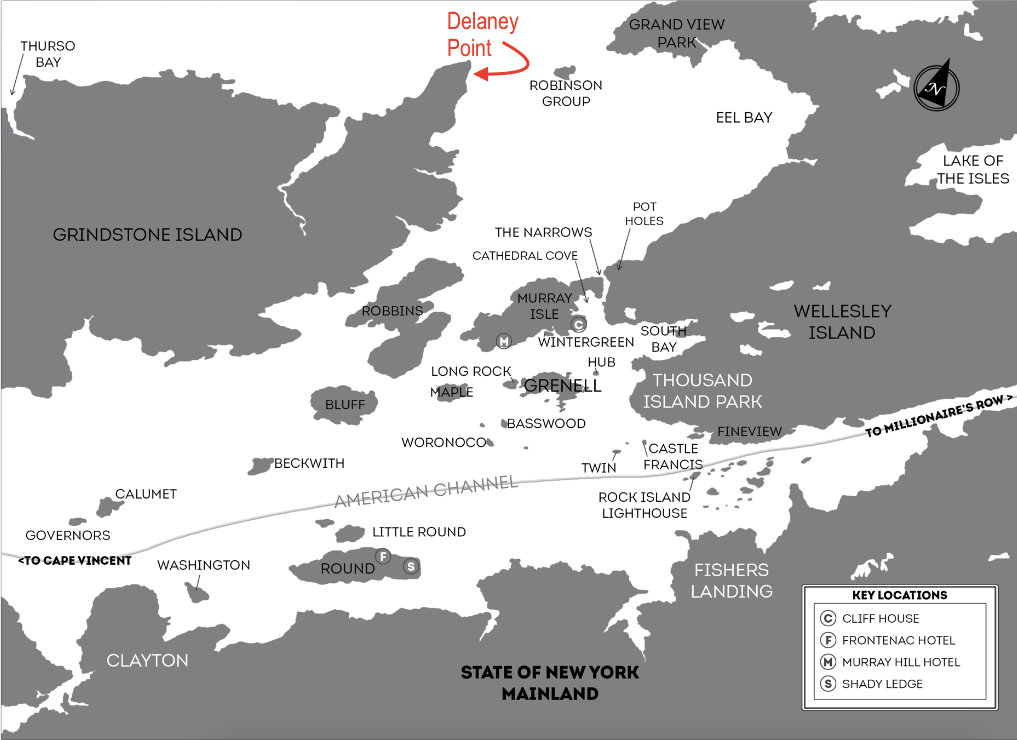
Summer resident Stanley Norcom described the hill on Delaney Point in his book, Grindstone: An Island World Remembered like this: "There, on an extensive shoreline acreage at the northeastern extremity of Grindstone Island, stood a glacial drumlin, a high conical hill covered with windswept beauty. It provided splendid views of the Lake Fleet and Navy groups of Canadian islands to the north."
Long before the loggers, the St. Regis Mohawks had summer encampments on this point. The Mohawks found the stone of this island excellent for sharpening their weapons, hence the name Grindstone Island. And as the story goes, the bay that fronts the point was named Eel Bay, for the eels they speared.
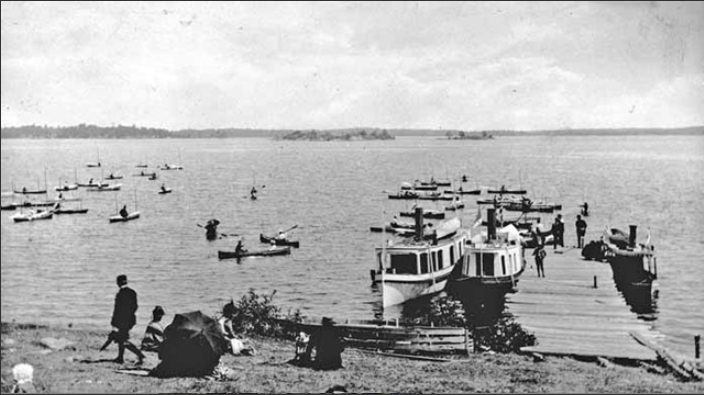
THEN CAME THE CANOEISTS
In 1883, the American Canoe Association held a rendezvous near Peterborough, Ontario, about one hundred miles NW of Delaney Point. Many of the US members were from New York City and on their way home, they explored the Thousand Islands region and fell in love with it. A committee traveled to Clayton later that fall to scout a possible location for an ACA rendezvous. They employed a local guide who suggested Delaney's Point on the northeast tip of Grindstone Island. The committee was thrilled with the location and described it as "a wooded, grassy knoll, sloping both towards the Canadian channel and Eel Bay, with a low, clean, and pebbly beach, gradually receding into the bay." They deemed Eel Bay to be the perfect spot for sailing canoes. They were especially thrilled that Delaney's was "within pistol-shot of the national boundary line, making it essentially an international affair." Being about four miles from Clayton, NY and five miles from Gananoque, ON, the location was convenient to both Canadians and Americans.
They liked that it was a quiet, remote spot, yet it was also easily accessible by train and steamboat. Members who lived in New York City could load their canoes onto an express train in the morning and have them delivered to the camp via steamer by noon the following day. In April 1884, John Delaney built a dock to prepare for the first summer of the ACA at Delaney Point.

Six hundred ACA members showed up for the rendezvous here in the Thousand Islands that first year. The canoeists loved the location so much that they held their camp there for three consecutive summers. It seems that the summer people of the Thousand Islands loved the ACA rendezvous, too. The ACA camp and events attracted much attention in the area. Just the sight of hundreds of canoes pulled ashore and sometimes as many as one hundred tents dotting the point attracted visitors.
Then, in 1887, the location was changed to Lake Champlain. There had been so much written about how the canoeist loved Delaney Point that I had to scratch my head and wonder why they would change locations. I knew that John Delaney had died. Perhaps the relationship between the Delaney family and the ACA had become acrimonious. Or perhaps the Delaney family was tired of having hundreds of canoeists on their property.
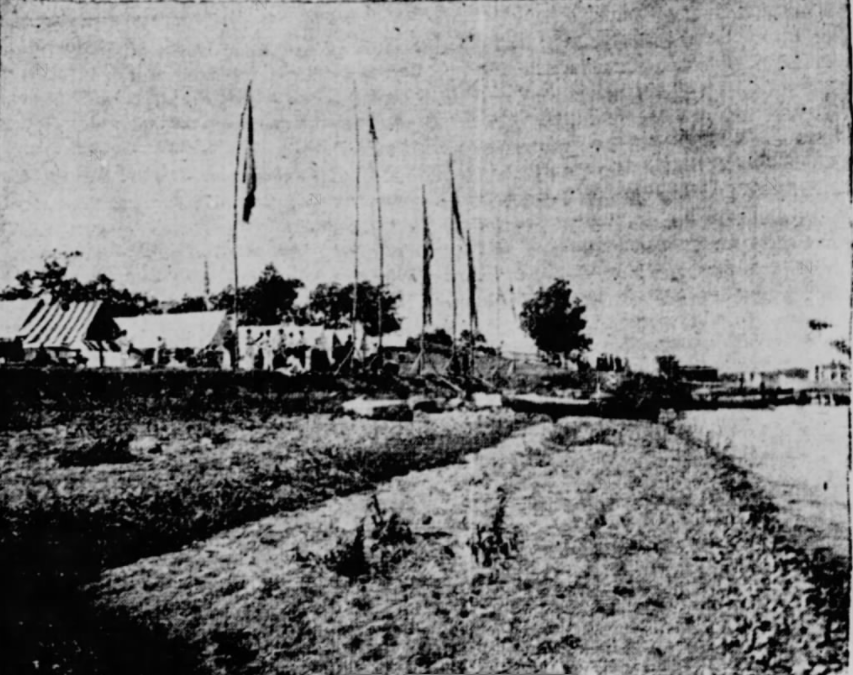
As always, I searched the newspaper archives for an answer and was rewarded with a March 16 1887 article Montpelier, Vermont newspaper, The Argus and the Patriot, which reported that the ACA had purchased Bow and Arrow Point at Lake Champlain as its new summer headquarters and permanent camp. The article went on to say: “The present annual meeting ground is among the Thousand Islands, but this is given up for the superior attractions of Lake Champlain. Dozens of new cottages will be built and camps instituted along the lakeshore the coming summer, and an unprecedented number of visitors is assured.”
Despite all their high hopes, the ACA’s new home at Lake Champlain did not measure up. It wasn’t big enough. The camp could only accommodate 200 canoeists. Many were turned away. Bow and Arrow Point was only used in 1887.
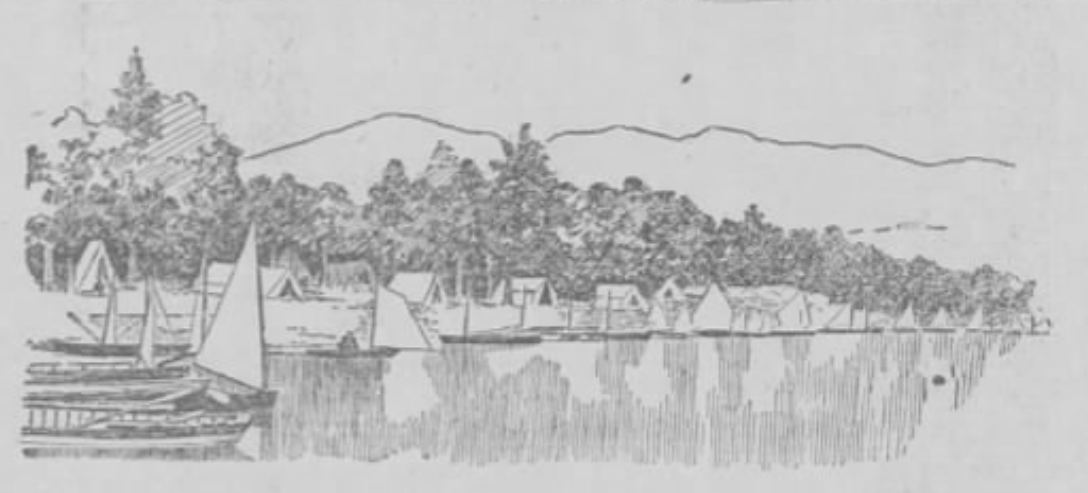
The ACA bounced around after that. They even returned to the Thousand Islands twice, both at Canadian sites. Finally, for their 17th anniversary, the ACA returned to Delaney Point. This was perhaps because the commodore that year was William Huntington from Rome, NY. He vowed to make it the biggest rendezvous ever. The Association built two structures on the point: a pavilion and a store. Over a thousand canoeists turned out.
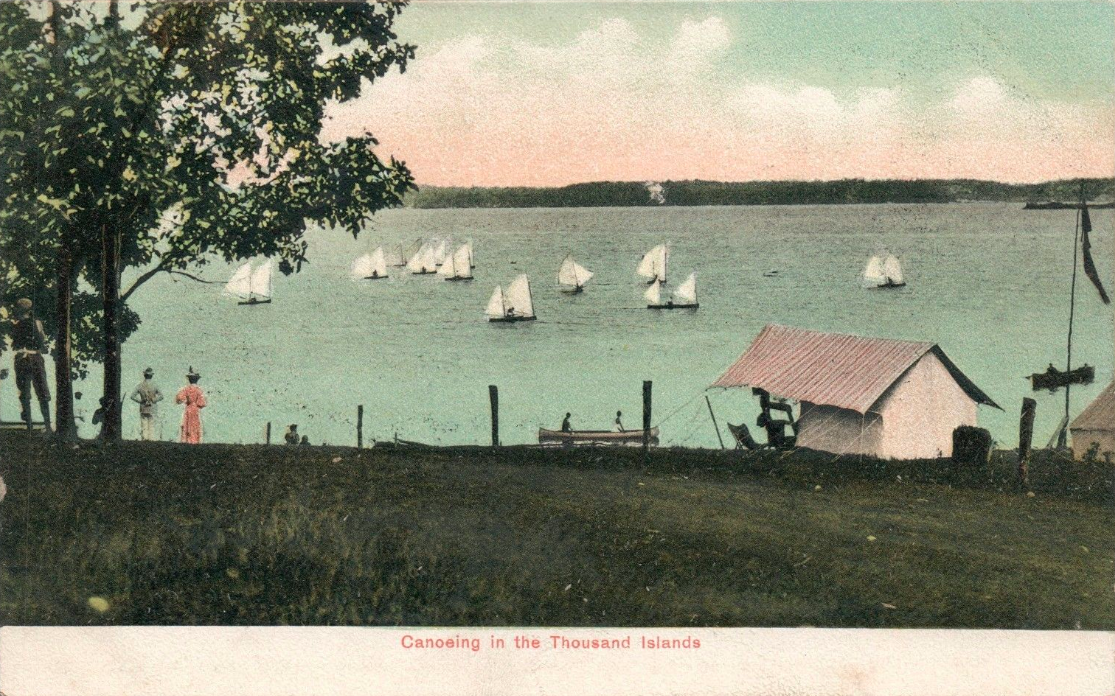

All in all, the ACA held five rendezvous at Delaney Point: 1884, 1885, 1886, and again in 1896 and 1897. The ACA might have continued to use the Eel Bay location, but the Delaney family sold the point to New York State after the 1897 rendezvous.
In 1903, the ACA purchased 38-acre Sugar Island near Gananoque, Ontario, not far away from Grindstone Island. And for those of you wondering, the ACA is still in existence and still has annual events in the Thousand Islands.
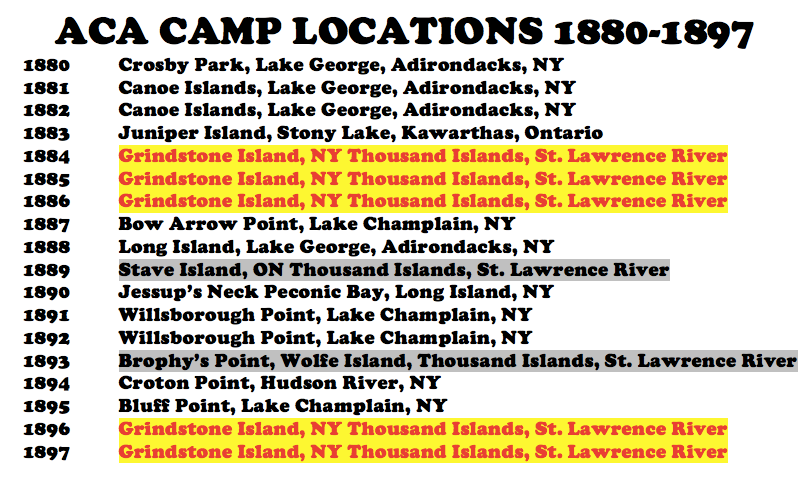
STATE LAND
By now, some of you have figured out that Delaney Point is more commonly known today as Canoe Point State Park. At the urging of the Anglers Association, the Department of New York State Forest and Game Commission bought land where fishing guides or fishermen could stop for a shore dinner. The Commission bought five sites for $20,000: Mary Island, Delaney Point (Grindstone), Cement Point (Grindstone), Wolf Point in Lake of the Isles, and half of Cedar Island.
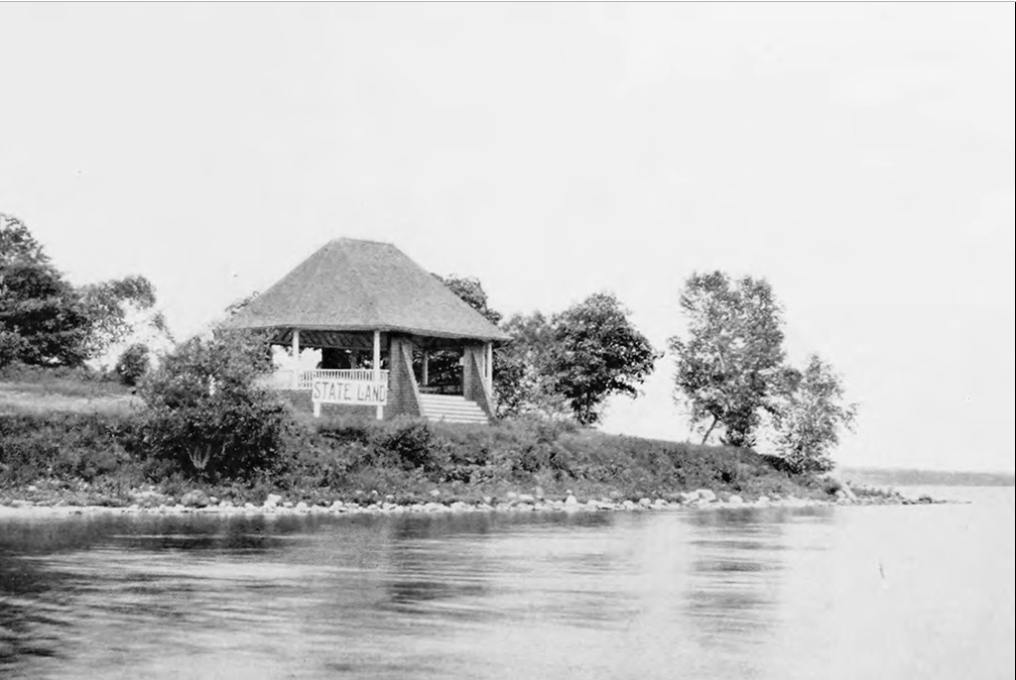
The Commission built a pavilion similar to the one that stands on Picnic Point today. A large sign was erected, which read: State Land. By 1899, it was known as Canoe Point. Ironic that when the ACA held their events there, it was either referred to as Grindstone Island or Delaney Point and it was only after the State of New York purchased the point that it became known as Canoe Point.
In 1905, The Malone Palladium reported: "The New York State Forest Commission, it is said, is soon to plant about 50,000 trees on Grindstone Island, in the St. Lawrence River. The trees will be oak, walnut, chestnut, and locust, averaging from one to two years old. The island is practically barren at present."
What they didn't mention was that nearly 80,000 trees—red oak, pin oak, chestnut, black locust, black walnut, white ash, and hickory—had been planted two years before. "Fully one-third of the trees planted were destroyed during the next winter by field mice, which burrowing under the snow, gnawed the bark away, or cut off the stem completely," according to a 1904 New York Forestry report. The 50,000 trees planted in 1905 were to replace the seedlings lost to the mice in 1904. This time, the mice were poisoned and a fence was built to keep grazing cattle away.
By 1920, the superintendent of State Forests described Canoe Point as a park with 70 acres and with two miles of shoreline that included, "two prominent points, together with a third point of less importance, with the names 'Canoe Point', 'Picnic Point' and 'Squaw Point' respectively." The superintendent reported "nice groves" on Canoe Point and Squaw Point and that the State maintained a good dock and a pavilion on both Canoe and Picnic Points.
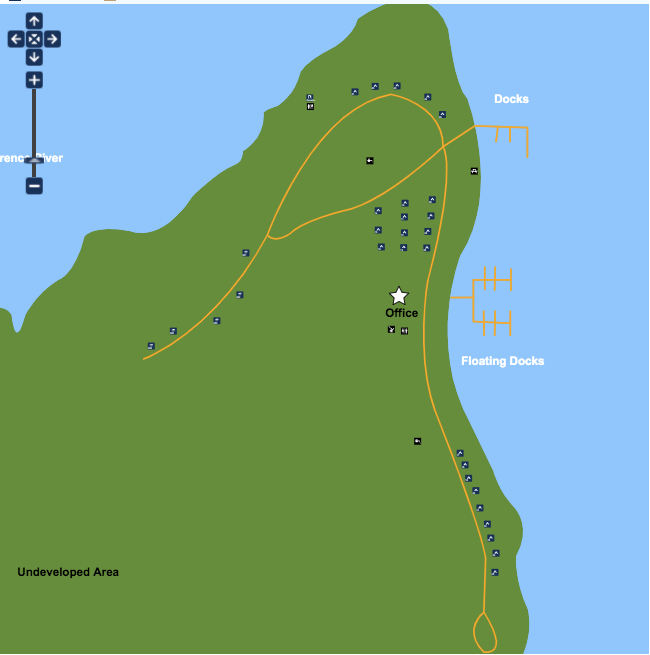
Ah! What a difference fifteen years had made. Now, a hundred years later, there is a lush well-established hardwood forest with five cabins, 31 campsites a pavilion and docks. Thank goodness for the foresight of the Anglers Association and the New York Forest and Game Commission.
By Lynn E. McElfresh, Grenell Island
Lynn McElfresh delights us every single month... this month's article is just as wonderful as her first, written in August 2009. She has taken us on so many journeys into the past as well as introducing us to some amazing people, places and things! Once again this article hits the mark since it's hard to be a boat around Grindstone Island and not wonder about the State Parks. (See her first 110 articles here! To see the rest of Lynn’s island experiences, search our new TI Life format under Lynn McElfresh.)
Lynn came to Grenell Island for the first time in 1975, to meet her fiancé’s family, Lynn has also written two novels in a series of nine novels about life in the Islands from 1883 to the 1960s. The third book, Grenell 1904, is almost here... and the fourth, Grenell 1912, is well underway!
See All About Lynn McElfresh & Her Books, written in the September 2020 issue of TI Life.
Editor's Note: Today The Grindstone Island Nature Trail, at the foot of Grindstone Island is nearly two miles of trail, connecting Canoe Point and Picnic Point State Parks. The trail is jointly maintained by the Thousand Islands Land Trust (TILT) and The New York State Office of Parks, Recreation and Historical Preservation.
The Nature Trail winds through the deep forests of Grindstone Islands and takes you across a boardwalk, providing incredible views of both the St. Lawrence River and the important wetlands of Delaney Bay. These wetlands serve to filter water, provide flood retention areas during large storms, and provide important nursery grounds for spawning fish and nesting birds.


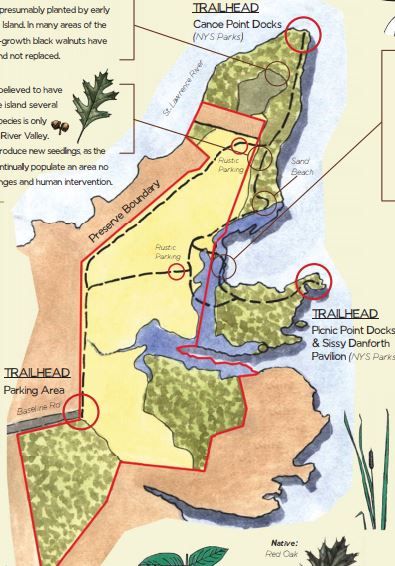
Trailheads can be found at both Canoe Point State Park and Picnic Point State Park. The Preserve is boat access only and visitors are encouraged to dock at either State Park's public docks to access the trail.
Click here to see all of TILT's Nature Trails including those on Grindstone Island.
Posted in: Volume 16, Issue 1, January 2021, Places, History
Please click here if you are unable to post your comment.
